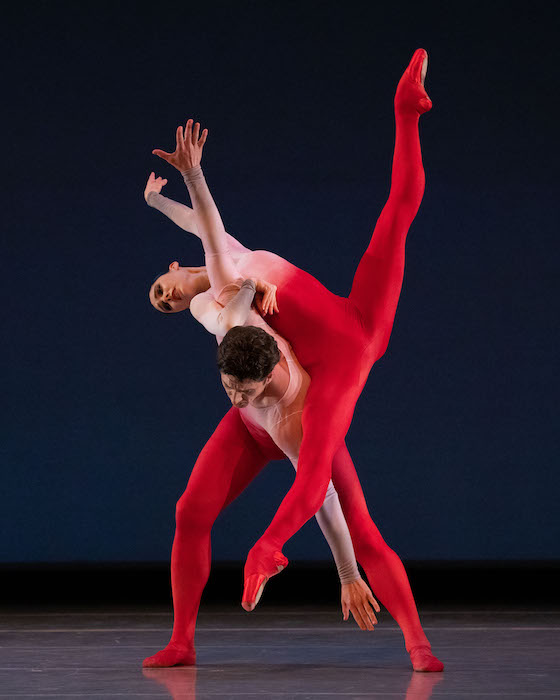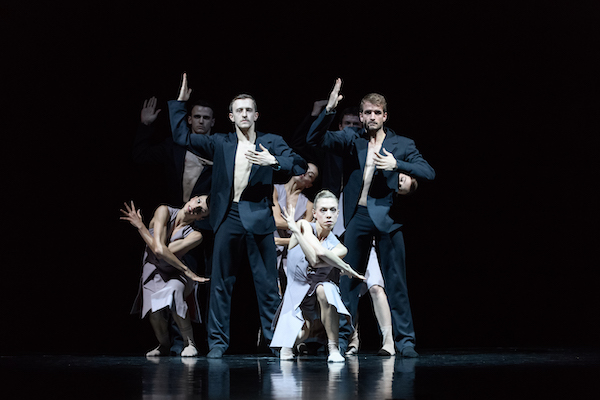Ballet West closes with compelling visions of the future

Beckanne Sisk and Christopher Ruud in Edwaard Liang’s “Constant Light” at Ballet West. Photo: Beau Pearson
Ballet West’s performance Saturday night at the Rose Wagner Performing Arts Center was not just the final one for the annual Choreographic Festival, but also the closing night for the company’s 2018-19 season. So it made sense that the audience burst into applause after Christopher Ruud performed a duet in the closing ballet, since Ruud is retiring after 21 years of performances with Ballet West.
At the end of Saturday night’s program, Ruud was honored by company director Adam Skulte, and presented with a plaque, while the audience gave him a standing ovation. There was a vivid feeling of appreciation and affinity, a fitting sentiment for a performance that highlighted the creative camaraderie of Ballet West’s artists.
Previous versions of the Choreographic Festival have showcased national companies and choreographers, but this year’s offerings were different: three of the five pieces on the program were choreographed by Ballet West dancers themselves.
The program opened with a performance by Scottish Ballet, the first international company to appear in the festival, and closed with a premiere for Ballet West by Edwaard Liang, the artistic director of Ohio’s BalletMet and a highly sought-after choreographer.
Each piece offered a different perspective on contemporary ballet, but the works made for Ballet West dancers by its own troupe stood out. Perhaps because the choreographers were all familiar with their own abilities and strengths, they took greater risks and offered unique visions.
Ballet West’s principal dancer Emily Adams choreographed But A Dream, a fantastical collage of interactions. Although the program notes named certain dancers “The Dreamer,” “The Racer,” “The Players” and “The Seekers,” there was no discernible plot or narrative thread. The cast of eight dancers seemed to savor the quirkiness of Adams’ movement vocabulary—balletic phrases that were accented with flexed feet or rippling spinal articulations. Set to music by Michael Nymanw, hich at times overpowered the nuances of Adams’s movement, But A Dream suggested the poetic and unpredictable imagery of dreamscapes. David Huffmire as “The Dreamer” imbued his phrases with a perfect balance of technical precision and dramatic extensions.

The Scottish Ballet Company performed Sophie Laplane’s “Sibilo” at Ballet West. Photo: Jane Hobson.
Ballet West’s first soloist Katlyn Addison choreographed Hidden Voices to Antonín Dvorák’s “American” String Quartet, Op. 96. This work began with a riveting trio by Joshua Whitehead, Hadriel Diniz, and Gabrielle Salvatto, who performed with exquisite clarity and refinement. Vibrant group scenes followed, as James K. Larsen’s lighting design brightened the stage with a warm, orange glow. Addison’s choreography presents a recognizably balletic vocabulary, but she generates a sense of ebb and flow by stretching the traditional steps so that positions transition fluidly from off-balance extensions into rolling, swirling combinations. Hidden Voices produced a beautiful sense of momentum and mutuality as the cast seemed to acknowledge and draw from the energy and investment of their peers.
In stark contrast, disquiet, by Ballet West demi-soloist Trevor Naumann, was a dramatic and disturbing work for a cast of seven. The dancers appeared to be infected by forces that made them squirm and writhe. Buzzing, vibrating music by Boaz Roberts intensified the sense of discombobulation, and the women’s long hair amplified every flailing motion. All of the dancers fearlessly inhabited Naumann’s choreography, and Lucas Horns gave a performance that was especially captivating and courageous.
It was exciting to see three ballets made by company members. They seemed to challenge the capacities of their fellow dancers, and their colleagues rose to the occasion and delivered outstanding performances. All year, the company has shone in more traditional repertory, like Swan Lake and Onegin, so it was intriguing to witness these possibilities for the future of ballet. Each of these three works generated a different mood with compelling imagery.
Opening the program, Scottish Ballet performed Sibilo, a piece created in 2016 by Sophie Laplane, who retired from Scottish Ballet in 2017 and now serves as the resident choreographer.
Sibilo began with the cast of eight, four men and four women, performing robotic sequences, gesturing in staccato phases, and partnering one another like puzzle pieces fitting together. The music by Alex Menzies drove the choreography and shifted the piece’s moods: when one couple broke apart from the group, they interacted with more comical and whimsical intentions. A throughline of the piece was the creative ways the dancers shed their costumes: during one duet with two men, they shared one jacket. The images of their different arms reaching through the jacket’s sleeves were poignant and intriguing.
Closing the program, Edwaard Liang’s new ballet, called Constant Light, featured a cast of 14. As the curtain lifted, they were all onstage, walking backwards, and then the music by Oliver Davis grew in volume. Dancers were dressed in unitards designed by David Heuvel that morphed from red legs to pink tops, with the women wearing red pointe shoes that matched the red of the unitards.
This design choice made their lines extend to stunning lengths, and Liang’s choreography presented a mixture of simplicity and power that made this work an ideal closer. The men were outstanding in a group section that highlighted the grace and precision of Chase O’Connell’s dancing, and Chelsea Keefer and Tyler Gum were terrific in a brief but explosive duet. An extended pas de deux for Beckanne Sisk and Christopher Ruud ended with the audience’s thunderous applause. Throughout the evening’s program, all the dancers brought a palpable sense of dedication to every step.
Ballet West’s 2019-20 season opens October 25 with Balanchine’s Ballets Russes. balletwest.org
Kate Mattingly is a dance scholar and historian. Her articles have appeared in The New York Times, the Village Voice, Dance and Pointe magazines, and Dance Research Journal. She received her doctoral degree from the University of California, Berkeley in 2017 and her dissertation analyzed the history and influence of dance critics in the United States. She is currently an assistant professor at the University of Utah.